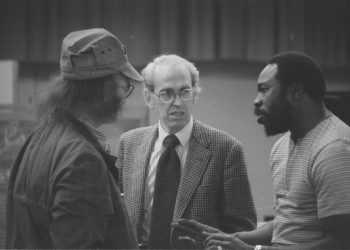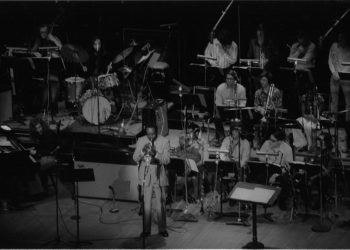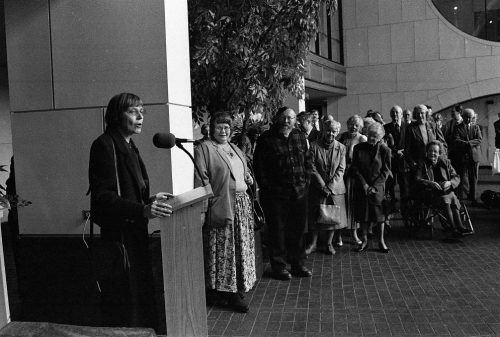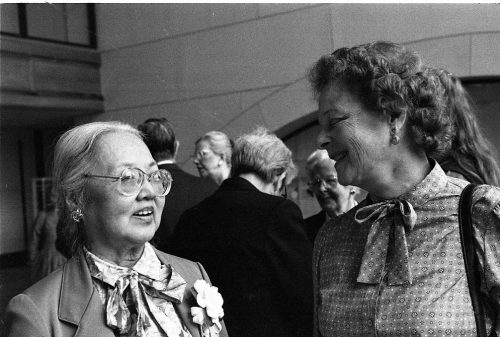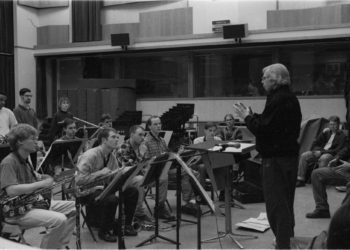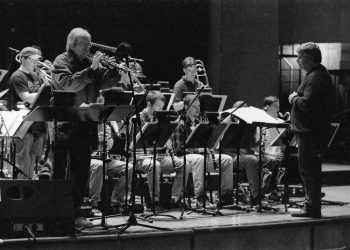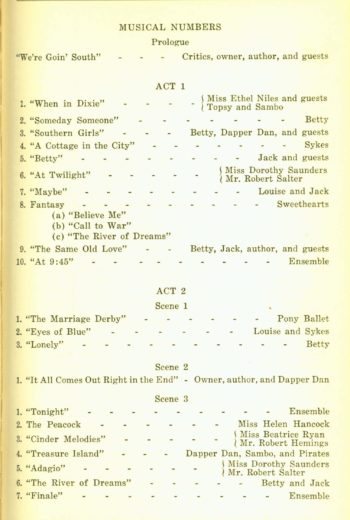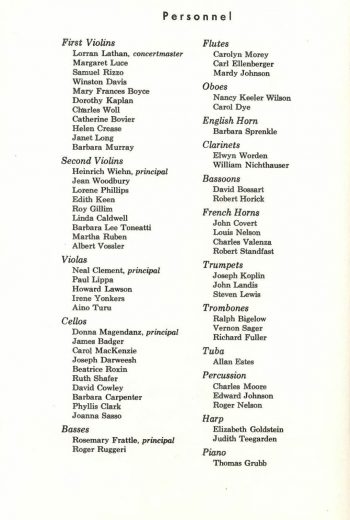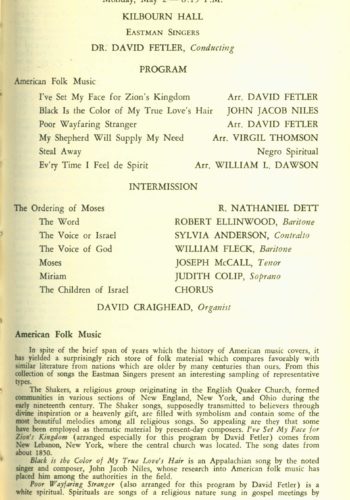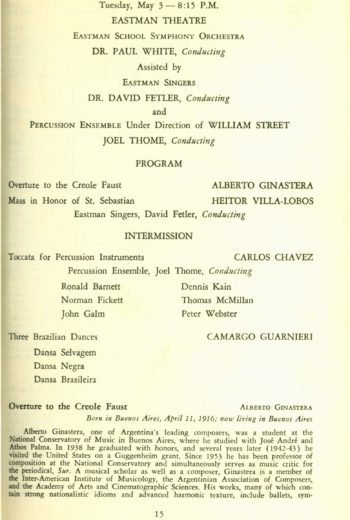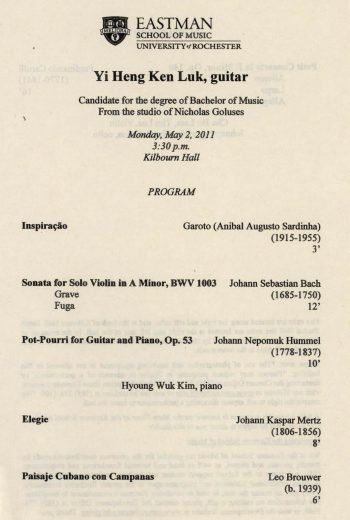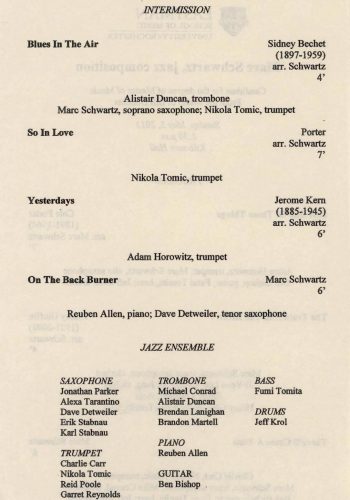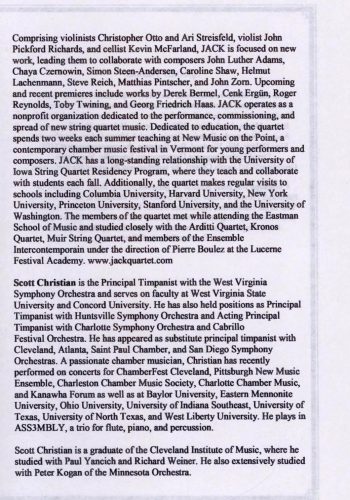Published on May 2nd, 2022
1973: Thad Jones guest appearance with the Eastman Jazz Ensemble
Thad Jones working with Eastman jazz students, likely the rehearsal space in the old Annex A building. May, 1973. ► carousel 1: R1696-10, R1696-11, R1696-12, R1696-13 ► carousel 2: R1696-16, R1696-17, R1696-18
Forty-nine years ago this week, on Saturday, May 5th, 1973, the renowned Thad Jones, composer-arranger, flugelhorn soloist, and trumpet soloist, appeared as guest conductor and soloist with the Eastman Jazz Ensemble. The young department of Jazz Studies and Contemporary Media, just then completing its third academic year under the leadership of Professor Rayburn Wright, was continuing to successfully attract high-profile artists as guest soloists, guest conductors, and mentors to Eastman School jazz performers.
Mr. Jones (1923-1986), both during his lifetime and since, has been hailed as one of the most polished trumpet soloists in the jazz world. He had been a member of the Count Basie Orchestra (and making a tremendous contribution to the ensemble with his arrangements and original works) before teaming up with Mel Lewis in 1965 to form the Thad Jones/Mel Lewis Orchestra. (Another member of that ensemble at its founding was Bob Brookmeyer, about whom I’ll have more to say below.) The Thad Jones/Mel Lewis Orchestra was going strong—very strong, indeed!—at the time of Mr. Jones’ guest appearance with the EJE; in 1978 the Orchestra would win a Grammy Award for their album Live in Munich. By the time of his Eastman appearance, Mr. Jones had also been teaching at William Paterson College (Wayne, New Jersey) where his archival collection resides. In 1979 he would move to Copenhagen, where he would take up direction of The Danish Radio Big Band, and would also teach at the Royal Danish Conservatory. He would return to the U.S. in 1985 to assume direction of the Count Basie Orchestra, Count Basie having died in 1984. Mr. Jones died in 1986, and was buried in Copenhagen, where a street is named for him.
The printed program for the May 5th, 1973 concert is displayed here. The second half of the concert was devoted to Mr. Jones’ contribution and artistry. The selections were not printed in the program, but Eastman Audio Archive (EAA) cataloguing data indicate that Mr. Jones led the following selections:
ABC Blues / Bob Brookmeyer (16:23)
The Little Pixie / Thad Jones (13:59)
Kids are Pretty People / Thad Jones (6:57)
A Child is Born / Thad Jones (7:48)
Fingers / Thad Jones (12:34)
Us / Thad Jones (7:49)
Of these selections, three in particular would become mainstays on Eastman School programs. “The Little Pixie” had nine Eastman performances between 1973 and 2017; “Kids are Pretty People” had twelve Eastman performances between 1973 and 2016; and “A Child is Born” had ten Eastman performances between 1973 and 2018. At least one other Thad Jones composition had already appeared on Eastman programs; the Eastman Jazz Ensemble had performed “Three and One” under Jack End in 1968, and under Chuck Mangione in 1969. Later, Wynton Marsalis would be guest soloist in his composition “Second Race” at Eastman in 1984.
Photographer Louis Ouzer was given uninhibited access to Mr. Jones and the members of the Eastman Jazz Ensemble during their rehearsing. The photos reveal much about the dynamic between the students and their famed guest. Another encounter with one of the greats: well done, Eastman Jazz Ensemble!
► Thad Jones in conversation with Ray Wright and an unidentified member of the Eastman Jazz Ensemble
R1696-1, R1696-3, R1696-4, R1696-6, R1696-7
► Thad Jones appearing as soloist with the Eastman Jazz Ensemble on-stage in the Eastman Theater. May, 1973.
R1694-8, R1694-9, R1694-10
► Thad Jones announcing selections from the stage during his appearance with the Eastman Jazz Ensemble.
R1694-5, R1694-6
1996: Ruth Watanabe and Special Collections in the Sibley Music Library
Twenty-six years ago this week, on Friday, May 3rd, 1996, the Sibley Music Library’s special collections unit was formally named in honor of former Head Librarian Ruth T. Watanabe, becoming the Ruth T. Watanabe Special Collections (RTWSC). The naming acknowledged Dr. Watanabe’s many professional contributions to both the Sibley Music Library and to the Eastman School of Music. The naming took the form of a formal dedication ceremony in the special collections unit on the Library’s fourth floor, followed by a gathering of more than 200 downstairs in what is today known as Sproull Atrium. Longtime friends of Dr. Watanabe and of the Eastman School were in attendance.

Ted Honea, Special Collections Librarian and Archivist, narrates an exhibit for guests on the occasion of the naming of the Ruth T. Watanabe Special Collections.
► R4210-9, R4210-10, R4210-11, R4210-12, R4210-13
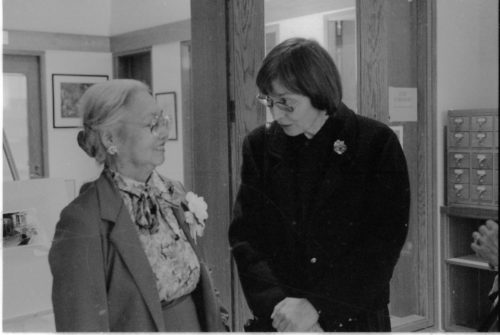
Well-wishers assembled in the atrium of Eastman Place (today, Sproull Atrium in Miller Center) for the reception following the naming of the Ruth T. Watanabe Special Collections. May, 1996.
► R4211-01, R4211-02, R4211-04
Friends, guests, and other well-wishers greeting Ruth Watanabe at the reception honoring her following the naming of the Ruth T. Watanabe Special Collections in the Sibley Music Library. May, 1996.
► R4211-08, R4211-10, R4211-12, R4211-15, R4211-17, R4211-20, R4211-23, R4211-27, R4211-31
The Sibley Music Library’s special collections unit was architecturally enabled by the “new” Sibley Music Library that opened in 1989. Earlier in time, soon after the Sibley Musical (as it was then called) Library was merged with the new Eastman School of Music in 1922, some closet space had been reserved for the “treasure” acquisitions that were anticipated. After a dedicated library building was built on Swan Street in 1937, a portion of the second stacks level was walled off to form a secure vault for rare books and manuscripts. As the decades passed, the Library acquired numerous archival collections of interest, together with the professional papers of several alumni and faculty members, but for want of proper working space, these were for the most part relegated to the “overflow” storage area in the building’s basement. Eventually, the “new” Sibley Music Library on Gibbs Street would be designed with special collections and archives in mind; a considerable extent of the fourth floor is dedicated to a department equipped with a secure vault, a reading room, a workroom, and offices, all ensuring the proper housing and administration of archival materials. RTWSC’s critical mass of content continues to grow as more collections are acquired each year.
To the Eastman School audience, Ruth Watanabe (RTW) scarcely needs an introduction; she has been amply written about in the academic press and in Eastman School publicity, and two excellent articles in the journal MLA Notes in recent years have celebrated her life.[1] RTW was born and raised in Los Angeles, graduated from USC, and was a graduate student there when the U.S. entered World War II. As a result of the sudden forcible removal of Japanese-American citizens from large areas of the West Coast, Ruth and her parents were placed in detention at the Santa Anita racetracks (today known as Santa Anita Park), and were later moved to a permanent facility in Colorado. RTW was granted an academic exit from this fate when the Eastman School’s Howard Hanson invited her to come to Rochester for graduate study in 1942. In time, Barbara Duncan appointed her to a full-time position on the staff of the Sibley Music Library; when Miss Duncan turned 65 in 1947, the Eastman School retired her and promoted RTW to the Head Librarian’s position. RTW would serve in that capacity with distinction, vastly expanding the Library’s general acquisitions program with blanket subscription plans set up with American and European publishers. RTW was active on the national level, serving in various capacities in the Music Library Association, and ultimately serving a term as its President in the years shortly before her retirement. RTW also undertook several buying European trips, much as her predecessor had done before her. Her service to the Sibley Music Library was complemented by her faculty service at the Eastman School, where she taught music history to undergraduates. She also served the community of Rochester as program annotator for the Rochester Philharmonic Orchestra’s subscription concerts, and as a diligent member of various groups, before which she occasionally appeared as invited speaker. When RTW retired in 1984, she was hailed as “the spirit of Meliora”[2] amid numerous honors and accolades, including a letter from then-President Ronald Reagan, a fellow Californian (though unlike RTW, a non-native one).[3]
The photos displayed here present RTW at various moments throughout her professional life. What I never cease to be charmed by is her infectious smile, which seems to have been ever-present, or nearly so. Returning alumni have told me stories of her prodigious recall, and of how she could lead a library patron on a walking tour of the library pulling sources off the shelves with a running commentary in one virtuoso bibliographic gesture. Towards the end of her life, I was also told by those close to her that her short-term memory had evaporated but her long-term memory was still intact. Indeed, I remember in particular one doctoral candidate in library and information science who was writing on some facet of library history for his dissertation, and who called on RTW in what would be the last year of her life. From her earliest adult years teaching while enrolled in graduate school, to the extraordinary service that she extended to others during the months in forced detention, to the vast totality of her incredible Eastman School life and career, hers was a life of service, nobly lived. The Ruth T. Watanabe Special Collections department stands and operates in her honor.

[1] “Eastman’s Ruth Watanabe” by Carol June Bradley, MLA Notes, volume 62, no. 4 (June, 2006), pags 904-925; and, “’For the good of our country: Ruth Watanabe and the ‘good that is in music’ at the Santa Anita Detention Center” by Alecia D. Barbour, MLA Notes, volume 74, no. 2 (December, 2017), pages 221-234.
[2] “Ruth Watanabe: the spirit of Meliora” by Robert Freeman in Eastman Notes, volume 18, no. 1 (August, 1985), page 13. In that same issue is “My Reminiscences” by RTW, pages 10-12.
[3] The letter resides in the Ruth Watanabe Papers at RTWSC. That collection contains no personal papers, but instead, is a gathering of professional papers emanating from RTW’s library administration and historical research on the Eastman School.
1997: Bob Brookmeyer guest appearance with the EJE and ENJE
On Friday, May 2nd, 1997, renowned trombonist and composer-arranger Bob Brookmeyer appeared as guest soloist with the Eastman Jazz Ensemble and the Eastman New Jazz Ensemble. The concert in the Eastman Theater featured ten original works by Mr. Brookmeyer—that is, five performed by each of the two ensembles. Once again, an established high-profile artist was appearing in concert with an Eastman School jazz ensemble, thereby continuing the succession of great artists who had been supporting Eastman Jazz by their presence ever since the Jazz Studies and Contemporary Media department (so named at its outset) was founded in 1970. Mr. Brookmeyer, in particular, was a close friend of Eastman Jazz for several decades. Prior to his 1997 guest appearance, he had come to Eastman in the summer of 1979 as a participant in the annual Arrangers’ Institute, and then had appeared as guest soloist with the Eastman Jazz Ensemble in February, 1982 and in February, 1987. He would return again in December, 2009 for a gala concert by the Eastman New Jazz Ensemble marking his 80th birthday. For those who happen to be on-site at school, service copies of the May 2nd, 1997 concert are available for listening in the Sibley Music Library (call numbers SDM 2429 and SDM 2430).
The late Mr. Brookmeyer’s work has been well-represented on Eastman concert programs in the past half-century, in both original works and arrangements. To cite just a handful of titles, his original work ABC Blues was performed in the EJE concert with Thad Jones on May 5th, 1973 cited above (Mr. Jones was both soloist and conductor), and has been performed at Eastman six times between 1973 and 2015 (on the last occasion, renowned trombonist Clarence Hines was guest soloist). Hello and Goodbye, seven Eastman performances between 1980 and 2020; The American Express, five Eastman performances between 1982 and 2018; his arrangement of W. C. Handy’s St. Louis Blues, six performances between 1980 and 2017; and his arrangement of Hoagy Carmichael’s Skylark, five performances between 1981 and 2015, and in addition, was performed in the 1979 Arrangers’ Holiday concert. In 2017, the Eastman New Jazz Ensemble gave the U.S. premiere of Mr. Brookmeyer’s large-scale work Electricity, which had previously been premiered in Europe. An Eastman performance of his large-scale masterwork On the Way to the Sky, what would have been the American premiere, had been planned for April, 2020 under Dave Rivello’s direction, but the onset of the pandemic prevented the performance from taking place.
Photographs of the Eastman performers rehearsing with Director Fred Sturm and with Mr. Brookmeyer are displayed here. Once again, photographer Louis Ouzer was granted uninhibited access to the performers as they went about their work. During the daytime rehearsal, Mr. Brookmeyer is seen not only in the capacity of soloist but and also that of director, speaking to the Eastman performers and conducting them, and engaging in informal conversation with them. What an amazing, worthwhile dynamic for our jazz performers when Bob Brookmeyer came to town.
► Photos by Louis Ouzer:
► Bob Brookmeyer addressing Eastman Jazz players during daytime rehearsal, May, 1997.
R4242-4, R4242-5, R4242-6
► Eastman Jazz Ensemble Director Fred Sturm conducts while Bob Brookmeyer is on solo valve trombone. May, 1997.
R4242-11, R4242-12, R4242-13, R4242-15
► Bob Brookmeyer directing members of the Eastman Jazz Ensemble in rehearsal, May, 1997.
R4242-20, R4242-21, R4242-22, R4242-23, R4242-24
► Bob Brookmeyer with Eastman jazz performers, informally conversing after rehearsal had ended. May, 1997.
R4245-10, R4245-12, R4245-15, R4245-16, R4245-19
► During a run-through in the Eastman Theater, Fred Sturm directs the Eastman Jazz Ensemble while Bob Brookmeyer is soloist on valve trombone. May, 1997.
R4249-6, R4249-7
► Bob Brookmeyer directing during a run-through in the Eastman Theater. May, 1997.
R4249-24, R4249-25, R4249-27, R4249-28
Mr. Brookmeyer (1929-2011) enjoyed a long and distinguished career as a trombonist, composer-arranger, and educator. A native of Kansas City, the young Brookmeyer began playing clarinet at age eight and trombone at age thirteen. As a young adult he freelanced widely in New York City, working with several different bands and with such artists as Coleman Hawkins, Pee Wee Russell, Ben Webster, Charles Mingus, and Teddy Charles. While working with Claude Thornhill, Mr. Brookmeyer began to play the valve trombone, making him one of the few professionals to favor that instrument over the slide trombone. In 1953, while playing with the Stan Getz Quintet, Mr. Brookmeyer was awarded the Downbeat Magazine “New Star Award” for trombone. In 1954-57 he performed with Gerry Mulligan’s ensembles—both the Gerry Mulligan Quartet (1954) and the Gerry Mulligan Sextet, appearing on numerous recordings as leader and guest soloist. Mr. Brookmeyer left Mulligan’s groups in late 1957 but in 1960 rejoined Mr. Mulligan as chief arranger/composer and featured soloist for his Concert Jazz Band (1960–64). Those years were also a time of collaborations with George Russell, Bill Evans, Thelonius Monk, Clark Terry, and also such notable artists as John Coltrane, Count Basie, Pepper Adams, Oscar Pettiford, Ben Webster, Art Blakey, Dizzy Gillespie, and Jimmy Jones. In 1965, Mr. Brookmeyer became a founding member of the Thad Jones/Mel Lewis Jazz Orchestra, dividing his time between arranging and playing lead trombone. In 1968, he moved to Los Angeles and, taking a decade-long break from jazz recording, worked as a staff arranger and session musician for motion pictures and television. In 1978 he came out of that self-imposed retirement with the album Back Again (Sonet Productions) and returned to New York. After playing with the Stan Getz Sextet on their European tour (1978), Mr. Brookmeyer formed his own quartet and began making new recordings. In 1979, he became musical director of Mel Lewis’s reorganized Jazz Orchestra, was awarded another NARAS nomination for Arranging and Best Album (Bob Brookmeyer: Composer, Arranger Live at the Village Vanguard, Gryphon), and, in 1980, received his first NEA grant for Jazz Composition.
In the 1980s Mr. Brookmeyer established himself as a prominent music educator, both at home and abroad. He served on the faculty of Manhattan School of Music, as Director of the BMI Composer’s Workshop, and also appeared as a clinician at various colleges and universities. In 1991 he moved to Rotterdam, where he organized the World School for New Jazz and also taught composition and improvisation at Rotterdam Conservatory. In 1994 he was appointed musical director of the Schleswig-Holstein Musik Festival Big Band, a worldwide jazz-based ensemble dedicated to new music that eventually evolved into Mr. Brookmeyer’s award-winning New Art Orchestra. In 1996 Mr. Brookmeyer was named artistic director of the Composition Workshop at Rhythmic Conservatory in Copenhagen. Returning home to the U.S. in 1997, Mr. Brookmeyer was appointed to a full-time position at New England Conservatory, where he chaired the department of jazz composition and also created the Jazz Composers’ Workshop Orchestra. He retired in 2007. His last recording, Standards, featuring his own New Art Orchestra with vocal soloist Fay Classen, was released a few weeks before his death in 2011.
Mr. Brookmeyer boasted an extensive discography, appearing both as leader and sideman on dozen of albums, including numerous recordings with various jazz icons. He was a winner of multiple Grammy Awards and also a three-time recipient of composition grants from the National Endowment for the Arts. An internationally recognized composer and arranger, Mr. Brookmeyer received commissions from the Netherlands Wind Ensemble, Swedish Radio Symphony, WDR Big Band, Metropole Orchestra in the Netherlands, The Twelve Cellists of the Berlin Philharmonic, Chamber Music America, The American Jazz Orchestra, and the New York Council on the Arts, among others. He received honorary doctorates from the University of Missouri-Kansas City (1991) and from the New England Conservatory (2008), and was named a National Endowment for the Arts Jazz Master in 2006.
Since 2015 Mr. Brookmeyer’s manuscripts and professional papers have resided at the Ruth T. Watanabe Special Collections in the Sibley Music Library, which has now become the primary repository of Mr. Brookmeyer’s legacy. The collection represents a comprehensive record of Mr. Brookmeyer’s creative life, most tangibly manifest in the sketches and autograph manuscripts of his original works and arrangements, together with numerous publications of his work. The administrative side of his creative life is manifest in his professional papers, which take the form of correspondence, printed programs, academic papers, degrees and awards, correspondence, and a substantive extent of photographs and other iconography. A truly special component of the collection lies in considerable extent of sound recordings, both commercial recordings and non-commercial. These embody Mr. Brookmeyer’s work in various formats and in numerous different performance and studio contexts, and including in particular generous coverage of the work of his New Art Orchestra. Inevitably, many an archival collection contains items of personal significance such as mementos or memorabilia or realia, items that might not serve any obvious research purpose, but that an archivist nevertheless deems desirable to retain based on perceived artifactual values. Such items can include those that bear witness to an individual’s associations with other persons or groups. One such item resides in box 109 of the Bob Brookmeyer Collection, that being a football that was presented to him by the members of the Eastman Jazz Ensemble and Eastman New Jazz Ensemble on the occasion of their May, 1997 collaboration. The football bears the inscription “THANKS BOB 1997 / EASTMAN JAZZ” and is signed by all members of the EJE and ENJE.
The Weekly Dozen
In this week’s “Weekly Dozen” we recognize a dramatic presentation in aid of the student yearbook (as the “Weekly Dozen” has previously shown, plays were staged in Kilbourn Hall once upon a time!); a concert by the Rho Chapter of Delta Omicron (back in the day when the Eastman School had three—three, count ‘em!—fraterity or sorority chapters); a choral performance of R. Nathaniel Dett’s oratorio The Ordering of Moses, a work completed by Mr. Dett for his masters degree here, and which will be performed by the Rochester Oratorio Society in the fall of 2022; a program of Latin American choral music given during the 1960 Festival of American Music; and some superlative student performances such as grace the Eastman concert calendar each week of the semester.
►May 2, 2011
►May 5, 2013
►May 3, 2016














